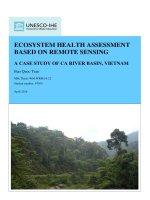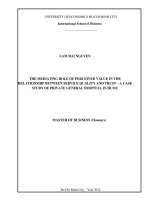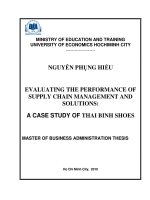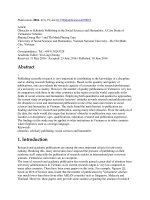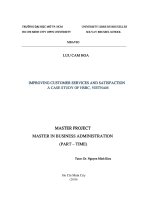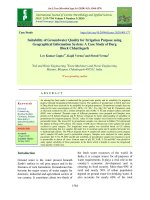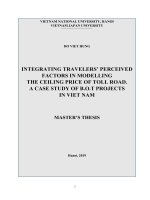landslide hazard and risk assessment for road network using rs and gis a case study of xin man district, vietnam
Bạn đang xem bản rút gọn của tài liệu. Xem và tải ngay bản đầy đủ của tài liệu tại đây (8.87 MB, 142 trang )
i
LANDSLIDE HAZARD AND RISK ASSESSMENT FOR ROAD
NETWORK USING RS AND GIS: A CASE STUDY OF XIN MAN
DISTRICT, VIET NAM
by
Lai Tuan Anh
A thesis submitted in partial fulfillment of the requirements for the
degree of Master of Engineering
Examinat
ion Committee:
Dr. Kiyoshi Honda (Chairperson)
Dr. Marc Souris
Dr. Ulrich Glawe
Nationality:
Previous Degree:
Vietnamese
Bachelor of Engineering in Geodesy
Hanoi University of Mining and Geology,
Vietnam
Scholarship Donor:
AIT Fellowship
Asian Institute of Technology
School of Engineering Technology
Thailand
May 2006
ii
ACKNOWLEDGEMENT
It is with delight that the author first of all extends his hearties gratitude to the Thesis research
committee Chairperson, DR Kiyoshi Honda for his professional guidance, advice,
encouragement throughout the study.
The technical and conceptual support of Dr Marc Souris, thesis committee member, helped me
to conduct the research for which I express my thanks to him.
Valuable suggestions support of Dr Ulrich Glawe and thesis committee member help me to
work enthusiastically so I am grateful to him.
I would like to express my sincere thanks to DANIDA for the scholarship and Star program
for the research grand, thereby making this study possible.
Special thanks go to RSL staff, Mr. Do Minh Phuong for providing all the necessary on time.
I am grateful to the local in Xin Man province who provided and guide me go to all the
landslide points to measurement GPS.
My vote of thanks goes to all my friends, Mr. Tran Trung Kien, Miss Dao Thi Chau Ha, for
their helps, supports, sharing the difficulties to my life in AIT.
Most of all, I want to express my deep appreciation to my family: Parents, my sister for their
endless love, constant support and encouragement for the graduate study.
iii
ABSTRACT
Xin Man district in the South west Ha Giang has high landslide hazard. However, the
available information on landslide in Xin Man district is still limited. We constructed the
essential spatial database of landslides using GIS techniques. The quantitative relationships
between landslides and factor s affecting landslides are established by the Certainty Factor
(CF). The affecting factors such as slope, elevation, landcover, geology, road distance,
lineament distance, drainage density are recognized. By applying CF value integration and
landslide zonation, the most significant affecting factors are selected.
By using RS&GIS technology landslide occurrences on all these factors have been analyzed.
The vector based GIS has been used for digitizing to produce thematic maps, as analysis for
study was based on the pixel based information therefore Raster based GIS has been used for
the analysis.
Pixel based calculation was made by using the CF value Model. By using the CF model we
obtain the CF value for all classes al all factor maps. On the basis of these CF value all factor
maps are recoded and matrix analysis was perform to produce a Landslide Hazard Zonation
map.
The Landslide Hazard Zonation map has been applied to develop a methodology to produce
hazard maps considering the behavior of landslide and to evaluate potential damage to
infrastructure specific road system. Different factors have been considered for this study.
iv
TABLE OF CONTENTS
CHAPTER TITLE PAGE
Title page i
ACKNOWLEDGEMENT ii
ABSTRACT iii
TABLE OF CONTENTS iv
LIST OF TABLES vi
LIST OF FIGURES vii
LIST OF MAPS ix
LIST OF ABBREVIATIONS x
1 INTRODUCTION 1
1.1 Background 1
1.2 Statement of problem 1
1.3 Objectives 2
1.4 Scope and limitation 2
2 LITERARUTE REVIEW 3
2.1 Hazard, risk & vulnerability 3
2.2 Landslide Hazard mapping 4
2.3 Fundamental of Remote sensing 5
2.4 GIS overview 12
2.5 Global Positioning System (GPS) 12
2.6 Web Map Server 12
2.7 Landslide Studies 15
3 DESCRIPTION OF THE STUDY AREA 18
3.1 Area and situation 18
3.2 Climate 18
3.3 Rainfall 18
3.4 Population 18
3.5 Geology 20
3.6 Elevation 22
3.7 Slope 24
3.8 Lineament 25
3.9 Road system 27
3.10 Drainage density 29
3.11 Landcover 30
4 METHODOLOGY AND ANALYSIS 33
4.1 General 33
4.2 Compilation of Required data 33
4.3 Field Survey by using GPS 34
4.4 Extraction of maps from the source data 35
v
TABLE OF CONTENTS (CONT.)
CHAPTER TITLE PAGE
4.5 Methodology and Analysis Data 38
4.6 Data Entry 40
4.7 Analysis data 41
4.8 Landslide Hazard Zonation Map 43
5 RESULTS AND DISCUSSIONS 44
5.1 Characterize several types of landslide in Xin Man district 44
5.2 Landslide Hazard Zonation map 46
5.3 Landslide Hazard Zonation map 54
5.4 Accuracy Check for Landslide Hazard Zonation Map 60
5.5 Develop a methodology to produce hazard maps considering the behavior of
landslides 62
5.6 Publish Landslide Hazard Zonation to Internet using Web Map Server 69
6 CONCLUSIONS AND RECOMMENDATIONS 76
6.1 Conclusions 76
6.2 Recommendation 77
APPENDICES 80
vi
LIST OF TABLES
TABLE TITLE PAGE
2.1 Landsat 7 ETM image characteristic 7
3.1 Geology, major litho-stratigraphic units with their corresponding classes 20
3.2 Area under Geology 21
3.3 Area under Elevation 22
3.4 Area under slope 24
3.5 Area under distance to lineament 26
3.6 Area under distance to road 27
3.7 Area under drainage density 29
3.8 Area under Landcover 30
4.1 Analysis data from different sources 34
4.2 Hazard zones 43
5.1 CF value of Geological 47
5.2 CF value of distance to lineament 48
5.3 CF value of slope angle 49
5.4 CF value of elevation classes 51
5.5 CF value of drainage density 52
5.6 CF value of landcover layer 53
5.7 CF value of distance to road 54
5.8 The hazard value ranges used for road buffer 55
5.9 The hazard value ranges used for whole area 55
5.10 % area for landslide hazard zone for buffer area 56
5.11 % area for landslide hazard zone for whole area 56
5.12 Defining the risk 64
5.13 Classification risk level 66
5.14 Result of the risk class based on buffer analysis 69
vii
LIST OF FIGURES
FIGURE TITLE PAGE
2.1 Criteria for risk assessment (Disaster Preparedness and Mitigation-2002) 4
2.2 Spectral reflectance of vegetation, soil and water 6
2.3 Spectral reflectance of a green left 7
2.4 The image interpretation processing 8
2.5 Data Flow in Remote sensing 9
2.6 The flow of geometric correction 10
2.7 Procedures of Classification 11
2.8 WFS Processing Request 14
2.9 Map of large Landslide areas of Vietnam 17
3.1 The yearly rainfall from 1961 to 2003 18
3.2 Location of Study area Xin Man district, Viet Nam 19
3.3 Geology chart 21
3.4 Elevation chart 23
3.5 Slope chart in Xin Man district 24
3.6 Distance to the lineament chart 26
3.7 Road area under the buffer 28
3.8 Drainage density chart 29
3.9 Landcover chart 31
4.1 Flo w Diagram For Landcover Map 35
4.2 Flow Diagram for Digitized Map 35
4.3 Flow Diagram for Landslide Map using GPS 36
4.4 Flow Diagram For TIN and maps extraction from TIN 37
4.5 Flow Diagram For Landcover Map extracted From Satellite Data 37
4.6 Flow Diagram for Buffered Road and lineament Maps 38
4.7 Methodology of thematic data layer preparation 39
5.1 Show the landslide attacked road. 44
5.2 Wedge slip occur along the road. 45
5.3 CF value of geological 48
5.4 CF value of distance to lineament 49
5.5 Statistical map of slope angle distribution in Xin Man District 50
5.6 CF value of slope angle layer 50
5.7 CF value of elevation layer 51
5.8 CF value of drainage density layer 52
5.9 CF value of landcover layer 53
5.10 CF value for distance road. 54
5.11 Bar chart showing the distribution of various hazard zones 57
for buffer area in Xin Man district 57
5.12 Bar chart showing the distribution of various hazard zones for whole area in Xin
Man district. 57
5.13 Relative distributions of various hazard zones and landslide probability within
each zone in road buffer in Xin Man district. 60
viii
LIST OF FIGURES
FIGURE TITLE PAGE
5.14 Relative distributions of various hazard zones and landslide probability within
each zone whole area in Xin Man district 61
5.15 The description of the road buffer 62
5.16 Show the process landslide 63
5.17 Schematization the Landslide area 63
5.18 Flow chart fo r procedure risk map 64
5.19 Minnesota Mapserver Framework Using CGI 70
5.20 Input data from the Mapfile 73
5.21 Study area on WMS 74
5.22 LHZ map in Xin Man on MapBrowser. 74
5.23 LHZ map on GMapFactory 75
ix
LIST OF MAPS
MAP TITLE PAGE
3.1 Tin in Xin Man district 19
3.2 Geological in Xin Man district 22
3.3 Elevation in Xin Man district 23
3.4 Slope in Xin Man district 25
3.5 Distance to lineament in Xin Man 27
3.6 Buffer road system in Xin Man 28
3.7 Drainage density in Xin Man 30
3.8 Landcover in Xin Man 31
3.9 Road system in Xin Man 32
5.1 Landslide distribution in Xin Man district 46
5.2 Landslide hazard zonation for buffer area in Xin Man 58
5.3 Landslide hazard zonation for buffer area in Xin Man 59
5.3 Risk of slope in Xin Man’s Road Network 65
5.4 Risk of distance to Xin Man’s road network 65
5.5 Risk in Xin Man 67
5.6 Risk assessment for road network in Xin Man 68
x
LIST OF ABBREVIATIONS
TIN Triangulated Irregular Network
DEM Digital Elevation Model
DTM Digital terrain Model
RS Remote Sensing
GIS Geographical Information System
GPS Global Position System
GML Geographical Mark Up Language
JPEG Join Photographic Experts Group
URL Uniform Resource Locator
WWW World Wide Web
WMS Web Map Service
WFS Web Feature Service
1
CHAPTER 1
INTRODUCTION
1.1 Background
Landslide has become one of the world’s major natural disasters for the few years in many
countries. Landslides are the most common natural hazard in mountainous terrain. Landslide
can be a major threat to population in the mountainous area. Even when they occur away from
the inhabited areas, landslide can be a significant hazard and have a serious economic impact
by blocking roads and river (Aniya, 1985; J. Achache, B. Fruneau and C. Delacourt 1995).
Landslides are widespread in many countries and cause great economic losses, especially
when engineering constructions are designed and erected without heeding the stability
conditions of the slopes (Q.Zaruba, V.Mencl 1967).
Landslides become a problem when they interfere with human activity. The frequency and
the magnitude of the slope failures can be increased due to human activities such as
deforestation or urban expansion.
Landslide hazard analysis is a difficult task. It requires large number of parameters and
techniques for analysis. Remote sensing and GIS are the powerful analysis tools to handle this
type of problems. A in the analysis of landslide spatial information e.g. topography, geology,
landcover, etc. are involved, therefore application of Remote sensing and GIS will be
effective.
1.2 Statement of problem
- Although landslide usually occur in Xin Man district, but people who live near or in the
landslide’s local do not illustrate the different between them. But actually, there are many
types of landslide which can occur and each of them have separate characterize. We need to
give some information to describe characterize some types of landslide in Xin Man district.
- Landslide is a serious disaster in Viet Nam. In recent 10 years, there are more than 10
areas occurred violent landslide, causing above 300 human deaths and thousands of hectares
of solids was buried by stone, sand, pebble and hundreds of inhabitant settlements having to
change their living places and locations. These are responsible for considerably greater socio-
economic loss than is generally recognized. There are some projects and research applying for
landslide but only for mid_center of Viet nam. Up to now, there is not hazard map, risk map
about landslide in Xin Man district, the leader of province only have measure to prevent
landslide every year and they have not had any project to study about landslide in the Xin Man
district. Hence, there is an urgent need to prepare landslide hazard zonation maps in the highly
landslide susceptible mountainous terrain special is Xin Man district.
- No other landslide investigation or risk assessment has been performed in Xin Man
district to date.
- Understanding and prevent landslide hazard is very important for every people. What can
people do when lack of information about natural hazard? Nowadays, internet is popular and
useful for every people. People can update, download all information and all thing which they
need to know. In this regard, we need to publish and share information about landslide on
Internet by using Web Map Sever.
2
1.3 Objectives
The general objective of this study is using Remote sensing and GIS technique to making
landslide hazard zonation mapping in Xin Man district.
The specific objectives of the study are:
1. Characterize several types of landslide in Xin Man district.
2. Create zoning maps for landslide hazard that usually occurs in Xin Man district.
3. Develop a methodology to produce hazard maps considering the behavior of
landslides
4. Publish and share landslide hazard zonation map’s information on internet using
Web Map Server.
1.4 Scope and limitation
- Landslide hazard map zonation will be focuses on critical physical factors by using GIS
overlaying thematic maps.
- To determine and localize area have high risk of landslide base on investigation, study
topology, geology, hydrology, and geomorphology.
- The limitation is associated with the availability of reliable and adequate data sets from
secondary sources to support making landslide hazard zonation map.
- Risk assessment only for road networks, not consider about the others as population,
economics, social…
- Data collection is not enough to be analysis.
- Landsat TM images will be used for analysis of landcover of the study area.
- Apply existing program to publish landslide hazard zonation map on internet using Web
Map Server.
3
CHAPTER 2
LITERARUTE REVIEW
Natural Hazard is extreme events in the earth’s ecosystem. The concepts of hazard, risk, and
vulnerability are often confused with one another and with the extreme event itself. Although
the extreme event is inherent in hazard, risk and vulnerability terminology, it is not
synonymous with the terminology. Therefore it is necessary to distinguish between the terms
hazard, risk and vulnerability.
Hazard assessment determines the type of hazardous phenomenon, frequency, magnitude and
the extent of the area that may be affected. Vulnerability indicates the degree of loss caused to
people, infrastructure, buildings, economies etc…distinguishing physical (buildings,
infrastructure), functional (lifelines, communication) and social aspects (health, population
density). Risk combines the knowledge about hazard and vulnerability to make a quantitative
prediction of the elements at risk, like numbers of lives to be possibly lost, people to be
injured, cost of property being damaged and destroyed or economic activities a affected.
2.1 Hazard, risk & vulnerability
In order to provide a systematic approach to study the landslide, Varnes (1984) defined
various types of hazard, risk & vulnerability.
Natural hazard the probability of occurrence of a potentially damaging phenomenon
within a specific period of time and within a given area.
Vulnerability the degree of loss to a given element or set of elements resulting from the
occurrence of a natural phenomenon of a given magnitude.
Element at risk the population, properties, economic activities etc… at risk in a given area.
Risk the expected degree of loss due to a particular natural phenomenon. Hence it is a
product of hazard and vulnerability.
Criteria for risk assessment is represented schematically as below (Figure2-1)
4
Figure 2.1: Criteria for risk assessment (Disaster Preparedness and Mitigation-2002)
2.2 Landslide Hazard mapping
2.2.1. Definition
Although by the term landslide is used for mass movements occurring along a well defined
slid ing surface, it has been used in literature as the most general term for all kinds of mass
movements, including some with little or no true sliding, such as rock-falls, topples, and debris
flows (Varnes, 1984) In this context, mass movement is used subsequently as a synonymous
term for landslide, similar to slope movement.
Zonation refers to the division of the land surface into areas and the ranking of these areas
according to degrees of actual or potential hazard. Hence landslide hazard zonation shows
potential hazard of landslides or other mass movements on a map, displaying the spatial
distribution of hazard classes. In general three basic principles or fundamental assumptions
guide all zonation studies (Varnes 1984).
Ø The past and the present are keys to the future: Natural slop failures in the future will
most likely occur where geologic, geomorphic and hydraulic situation have led to past
Elements at
risk
Persons
Structures
Landuse
Activities&
Funtions
Human
Vulnerability
Structural
Vulnerability
Land
Vulnerability
Funtional
Vulnerability
Vulnerability
Assessment
Risk
Assessment
Hazard
Hazard
Zonation
Vulnerability
5
and present failures. Thus, we have the possibility to estimate the features of potential
future failure. The absence of past and present failures does not mean that failures will
not occur in the future.
Ø The main conditions that cause landslides can be identified: The basic cause of slope
failures can be recognized, are fairly well known from several case studies and the
effects of them can e rated or weighed. It is possible to map correlate the contributing
factors to each other.
Ø Degree of hazard can be estimated: If the condition and processes that promote
instability can be identified, it is often possible to estimate their relative contribution
and give them some qualitative or semi-quantitative measurement. Thus, a summery of
the degree of potential hazard in an area can be built up, which depends on the number
of failure including factors present, their severity, and their interaction.
2.2.2 Scale of mapping for landslide hazard zonation
There are several technique for landslide hazard zonation can be applied, making use of GIS.
Therefore the appropriate scale on which the data is collected and the result presented varies
considerably. More detailed hazard maps require more detailed input data. Thus the objective
of the analysis and the requires accuracy of the input data determine the scale.
The following scales of analysis have been differentiated for landslide hazard zonation
according to the definition by the International Association of Engineering geologists (1976):
§ National scale(<1:1,000,000)
§ Regional scale(1:100,000 – 1: 1,000,000)
§ Medium scale(1:25,000 – 1:100,000)
§ Large scale( 1:2,000 – 1:25,000)
2.3 Fundamental of Remote sensing
2.3.1 Concept of Remote Sensing
Remote sensing is defined as the science and technology by which the characteristics of the
objects of interest can be identified, measured or analyzed the characteristics of the objects
without direct contact.
Electromagnetic radiation, which is reflected or emitted from an object, is the usual source of
remote sensing data. A device, to detect the electro-magnetic radiation, reflected or emitted,
from an object is called a “remote sensor” or “sensor”. A vehicle to carry the sensor is called a
“platform”.
Remote sensing is classified into three types with respect to the wavelength regions.
Ø Visible and reflective Infrared remote sensing.
Ø Thermal infrared remote sensing.
Ø Microwave remote sensing.
6
2.3.2 Spectral Reflectance of Landcovers
Spectral reflectance is assumed to be different with respect to the type of landcover.
This is the principle that in many cases it allows the identification of landcovers with remote
sensing by observing the spectral radiance from s distance far removed from the surface.
Fig.2.2 shows three curves of spectral reflectance for typical land covers; vegetation, soil and
water. As seen in the figure, vegetation has a very high reflectance in the near infrared region,
though there are three low minima due to absorption.
Soil has rather higher values for almost all spectral regions. Water has almost no reflectance in
the infrared region.
Figure 2.2: Spectral reflectance of vegetation, soil and water
Figure 2.2 shows two detailed curves of leaf reflectance and water absorption. Chlorophyll,
contained in a leaf, has strong absorption at 0.45 m and 0.67 m, and high reflectance at near
infrared (0.7-0.9 m). This results in a small peak at 0.5-0.6 (green color band), which makes
vegetation green to the human observer.
Near infrared is very useful for vegetation surveys and mapping because such a steep gradient
at 0.7-0.9 m is produced only by vegetation.
Because of the water content in a leaf, there are two absorption bands at about 1.5 m and 1.9
m. This is also used for surveying vegetation vigor.
7
Figure 2.3: Spectral reflectance of a green left
2.3.3 Description of the data set-Landslide image
Database of remote sensing is used in this thesis is Landsat 7 ETM. The application of satellite
data has increased enormously in the past decade. After the initial low-spatial resolution
images of the LANDSAT MSS ( which were about 60 by 80 m), LANDSAT now has a
significant improve in its characteristics with thematic mapper (TM) images. It has a spatial
resolution image of the 30 m and excellent spectral resolution. Landsat TM provides sevens
bands to cover the entire visible, near infrared and middle infrared portions of the spectrum,
with one additional band providing a lower resolution of the thermal infrared (table 2-1).
Landsat satellite orbits are arranged to provide good coverage of a large portion of the earth’s
surface. The satellite passed over each location every 18 days, offering a theoretical temporal
resolution of 18 days.
Table 2.1: Landsat 7 ETM image characteristic
Band Spectral range(µm) Spatial resolution(m)
1 0.45-0.52 30
2 0.52-0.60 30
3 0.63-0.69 30
4 0.76-0.90 30
5 1.55-1.75 30
6 10.4-12.5 60
7 2.08-2.35 30
Pan 0.50-0.90 15
8
2.3.4 Image interpretation
Image interpretation is defined as the extraction of qualitative and quantitative information in
the form of a map, about the shape, location, structure, function, quality, condition,
relationship of and between objects, etc. by using human knowledge or experience.
Information extraction in remote sensing can be categorized into four types which are as
follows:
Classification is a type of categorization of image data using spectral, spatial and temporal
information.
Change detection is the extraction of change between multi-date images.
Extraction of physical quantities corresponds to the measurement of temperature, atmospheric
constituents, and elevation and so on from spectral.
Identification of specific features is the identification, for example, of disaster, lineament and
other feature etc.
Figure 2.4 show a typical flow of the image interpretation process:
Figure 2.4: The image interpretation processing
2.3.5 Image Processing System
The remotely sensed data are usually digital data. Together information from that we
need data processing. The processes are given in the chronological order:
Ø Input data.
Preparation
Pre-works
Image measure
Image analysis
Thematic Map
Image reading
9
Ø Reconstruction/ correction.
Ø Transformation.
Ø Classification.
Ø Out put.
Figure 2.5 shows the data flow in remote sensing.
Figure 2.5: Data Flow in Remote sensing
Reflection/Radiation of
Electromagnetic Radiation
Camera Scanner
A/D conversion using a
film scanner etc.
Primary Processing D/D
conversion.
Digital Image
Reconstruction
/ Correction
Transformation Classification
Mapping
Transformed
image
Classified
image
Hard/Soft copy
Database
10
2.3.6 Geometric Correction
Geometric correction is undertaken to avoid geometric distortions from a distorted image, and
is achieved by establishing the relationship between the image coordinate system and the
geographic coordinate system using calibration data of the sensor, measured data of position
and attitude, ground control points, atmospheric condition etc.
The steps to follow for geometric correction are as follows:
Figure 2.6: The flow of geometric correction
There are three methods of geometric correction as mentioned below:
-Systemmetic correction.
-Non-systemmatic correction.
-Combined method.
2.3.7 Registration and Rectification
Refael C. Gonzalez Rechard E. Woods (1993) explained that the another important application
is the image registration or finding correspondence between two images. The procedure for
image registration is the same as the method just illustrated for geometric correction.
However, the emphasis is on transforming an image so that it will correspond with another
image of the same science but viewed perhaps from other prospective.
2.3.8 Classification
Classification of remotely sensed data is used to assign corresponding levels with respect to
groups with homogeneous characteristics, with the aim of discriminating multiple objects from
each other within the image.
Input image
(1) Selection of method
(2) Determination of parameters.
(3) Accuracy check
(4) Interpolation and resampling
a. System
etic correction.
b. Non-systematic correction.
c. Combined method.
11
Figure 2.7: Procedures of Classification
Ø Supervised Classification.
It is done in order to determine rule of classification. It is necessary to know the spectral
characteristics or features with respect to the population of each class. The spectral features
can be measured using ground based spectrometers. However due to atmospheric effects,
direct use of spectral features measured on the ground are not always available, for this reason,
sampling of training data from clearly identified training areas, corresponding to defined
classes is usually made for estimating the population statistics. Statistically unbiased sampling
of training data should be made in order to represent the population correctly.
Ø The minimum distance classifier is used to classify unknown image data to classes which
minimize the distance between the image data and the class in multi-feature space. The
distance is defined as an index of similarity so that the minimum distance is identical to the
maximum similarity.
Ø The maximum likelihood classifier is one of the most popular methods of classification in
remote sensing, in which a pixel with the maximum likelihood is classified into the
corresponding class. The likelihood is defined as the posterior probability of a pixel
belonging to class k.
2.3.9 Spatial Filtering
Spatial filtering is used to obtain enhanced images or improved images by applying, filter
function or filter operators in the domain of the image space (x,y) or spatial frequency (x,h).
Spatial filtering in the domain of image space aims at image enhancement with so-called
enhancement filters, while in the domain of spatial frequency it aims at reconstruction with so-
called reconstruction filters, which is in the domain of spatial frequency it aims at
reconstruction with so called reconstruction filters. An output image from filtering of spatial
pass filters, band pass filter etc. are typical filters with frequency control. Low pass filters
which out puts only lower frequency, noise, while high pass are used for example stripe noise
of low frequency.
12
2.4 GIS overview
2.4.1 Geographic Information System
According to Burrough (1986), Geographic Information system (GIS) is a powerful set
of tools for collecting, retrieving, transforming, and displaying spatial data from the real world
for a particular set of perposes.
Aronoff (1993) states that GIS is designed for the collection, storage and analysis of
objects and phenomena where geographic location is critical to analysis. For example, the
location of a fire station or the locations where soil erosion is most severe are key
considerations in using information. In each case, what it is and where it is must be taken into
account.
2.4.2 Terrain Modeling for Mountain
Mountain may be defined as dynamic system in which both the extent and variability
in relief are key controlling elements. Altitude, aspect and slope strongly both the human and
the physical characteristics of mountain ecosystems, such as the distribution of agriculture, the
type of forestry, micro and local climates and the extent of the mass movement. A model of
relief is therefore an essential component of a mountain GIS. At present the most powerful
method of representing relief is to construct a mathematical model of the earth’s surface: a
digital terrain model( DTM) or digital elevation model(DEM). This mathematical model can
be used to drive information on height, aspect, slope, angle, watersheds, hill shadows and cut
and fill estimates which may be essential components of management plan or inputs to a
process model.
Any digital representation of continuous variation of relief over space is known as a
DEM. DEMs were originally developed for modeling relief; they can of course be used to
model the continuous variation of any other attribute Z over two dimensional surfaces
(Burrough, 1986).
2.5 Global Positioning System (GPS)
The U.S Department of defense developed a navigation system called Global
Positioning System “GPS”. It is based on the 24 satellites which orbit around the earth at an
altitude of 20,200 km. the satellites are high enough to avoid land based system problems.
With this technology one can find the location of an object any where in the world 24hrs day.
The accuracy for measurement with GPS is from 5 to 10 meters range. With differential post
processing the accuracy can be few millimeter.
GPS is digital electronic equipment based on satellite ranging; it means we can figure out our
position on earth by measuring our distance from a group of satellites in space. The satellites
act as a reference point.
There are atom clocks on the satellites which are show accurate time, due to which we can
eliminate any error caused by the watch of the GPS receiver.
2.6 Web Map Server
2.6.1 Introduction
Open Source software and its specifications are the foundation of this study. PostgreSQL, the
Object Oriented Relational database stores and manages the GIS database. PostGIS is the
13
extension which makes the PostgreSQL connected to the Minnesota MapServer in order to
display the database in various formats. Minnesota MapServer is used to explore GIS data
over World Wide Web (WWW).
Open Source technology is base on the premise that the programming source code is freely
available to anyone who wishes to read, add to, or even modify and redistribute the computer
software code. Open source technology offers a level of stability and flexibility that is not
typically available with “out-of-the-box” software.
Benefit of Open Source Technologies
Ø Free to use- there are no licensing fees.
Ø The software can be duplicated and installed on as many machines in as many
environments, with no restrictions.
Ø Full access to source code.
Ø Highly responsive to end user requirements.
Open source does not just mean access to the source code. The distribution terms of open-
source software must comply with the following criteria:
a. Free redistribution.
b. Source Code.
c. Derived Works.
d. Integrity of the Author’s Source Code.
e. No Discrimination against Persons or Groups.
f. License Must Not Be Specific to a Product.(Open GIS).
Minnesota Map Server provides Open GIS Consortium’s (OGC) Web map Service(WMS) and
Web Feature Service. These two specifications will use operation on the client’s request to
produce maps of georeferenced data in various formats such as JPEG, PNG, GIF and GML.
2.6.2 Open GIS Standard
The OpenGIS Standard specifies the behavior of a service that produces georeferenced
maps. This standard specifies operations to retrieve a description of the map offered by a
service instance, to retrieve a map, and to query a server about features displayed on a map.
OpenGIS Standard is applicable to pictorial renderings of maps in a graphical format. This
standard is not applicable to retrieval of actual feature data or coverage data values.
1. Web Map Service (WM S) Implementation Specification
A Web Map Service produces maps of georeferenced data. We defined a ‘Map” as a
visua l representation of geodata; a map is not the data itself. These maps are generally
rendered in a pictorial format such as PNG, GIF or JPEG, or occasionally as vector-based
graphical elements in Scalable Vector Graphics (SVG) or Web Computer Graphics Metafile
(WebCGM) formats. This specification standardizes the way in which maps are requested by
client and the way that servers describe their data holdings. The three operations are as
follows:
14
Ø GetCapabilities (Required): Obtain service-level metadata, which is a machine readable
(and human- readable) description of the WMS’s information content and acceptable
request parameters.
Ø GetMap (required): Obtain a map image whose geospatial and dimensional parameter are
well-defined.
Ø GetFeatureInfo( optional): Ask for information about particular features shown on a map.
A standard web browser can ask a Web Map Service to perform these operations simply by
submitting requests in the form of Uniform resource Location (URLs). The content of such
URLs depends on which of the task is requested. All URLs include a specification version
number and a request type parameter. In addition, when invoking GetMap a WMS Client can
specify the information to be shown on the map (one or more” Layers”), possibly the “style”
of those Layers, what portion of the Earth is to be mapped (a “ Bounding Box”), the projected
or geographic coordinate reference system to be used (the “ Spatial reference System, “or
SRS), the desired output format, the output size (Width and Height), and background
transparency and color. When invoking GetfeatureInfo the Client indicates what map is being
queried and which location on the map is of interest.
2. Web Feature Service (WFS) Implementation Specification
The OGC Web Map Service allows a client to overlay map images display served from
multiple Web Map Services on the Internet. In a similar fashion, the OGC Web Feature
Service allows a client to retrieve geospatial data encoded in Geography Markup Language
(GML) from multiple Web Feature Services.
The WFS operations support INSERT, UPDATE, DELETE, QUERY and DISCOVERY
operations on geographic features using HTTP as the distributed computing platform.
Figure 2.8: WFS Processing Request
Client
Web Feature Service
(WFS)
WFS Request WFS Response
15
2.7 Landslide Studies
-Kwang-Hoon Chi*, Kiwon Lee**, and No-Wook Park*(2001), studied Landslide
Stability Analysis and Prediction Modeling with Landslide Occurrences on KOMPSAT EOC
Imagery. In this study, Slope-Area plot methodology followed by stability index mapping with
these hydrological variables is firstly performed for stability analysis with actual landslide
occurrences at Boeun area, Korea, and then landslide prediction modeling based on likelihood
ratio model for landslide potential mapping is carried out; in addition, KOMPSAT EOC
imagery is used to detect the locations and scarped scale of landslide occurrences. These two
tasks are independently processed for preparation of unbiased criteria, and then results of those
are qualitatively compared. As results of this case study, land stability analysis based on
DEM-based hydrological variables directly reflects terrain characteristics; however, the results
in the form of land stability map by landslide prediction model are not fully matched with
those of hydrologic landslide analysis due to the heuristic scheme based on location of existed
landslide occurrences within prediction approach, especially zones of not-investigated
occurrences. Therefore, it is expected that the results on the space robustness of landslide
prediction models in conjunction with DEM-based landslide stability analysis can be
effectively utilized to search out unrevealed or hidden landslide occurrences.
-D.Z.Seker, M.O.Altan(2001)used various types of data to extract relevant information.
This study is to determine a suitable methodology for predicting possible landslide areas and
producing landslide risk map in the study area of Sebinkkarahisar Township, which is located
at the northeastern part of Turkey. These include the satellite sensor data taken in the year of
1987 and 2000, which are use for the extraction of land surface temperature and landuse
information. 1:25000 scale standard topographic map has been digitized and the obtained
contours were used for the derivation of DEM and slope map of the study site. Satellite
images, DEM and slope map of the study area were used to investigate the possible landslide
risk areas and reason of this natural hazard which threat the study area frequently.
-Nguyen Quoc Phi, Bui Hoang Bac (2000) gives a view of landslide characteristics on
natural terrain of YangSan area, Korea and developing a GIS approach to modeling slope
instability. The relations between landslide distributions with the physical parameters such as
lithology, elevation, slope gradient, slope aspect, lineament, drainage, vegetation, and land sue
were analyzed by Bayesian statistical model. A susceptibility map is modeled by incorporating
these in weight of evidence model using Bayesian approach.
-Atsushi Kajiyama, Takamoto, Truong Xuan Luan and Nhu Viet Ha (2002) used
stereo-photogrammetry technique (using Photomodeler software) application for monitering a
landslide twice in Monset area, northwestern part of Viet Nam in 2002 to 2003. this technique
has allowed us to deriver surface deformation maps of landslide with a high spatial resolution
and accuracy. Photomodeler software can treat it easily using reference point and the
photograph, which they have been taken photograph with common digital camera. Using this
software, we estimated the amount of movements of whole landslide for one year. The result
has been validated by comparing independent measurements carried out by laser telemeter.
-Mike Doratti, Chris McColl and Claire Tweeddale (2002) applied GIS to predict
landslide hazard areas following clearcut logging events. The landslide prediction study
project sponsor is Tom Millard of BC Ministry of forest. The objective of this project is to
produce a report and maps identifying potential landslide hazard areas within the Cascade


